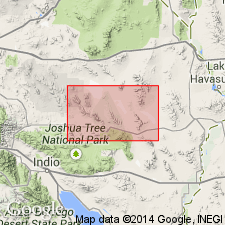
- Usage in publication:
-
- Iron Granodiorite Gneiss*
- Modifications:
-
- Named
- Dominant lithology:
-
- Granodiorite gneiss
- AAPG geologic province:
-
- Mojave basin
Summary:
Unit is named the Iron Granodiorite Gneiss of the Iron Mountains Intrusive Suite (new) in the Iron Mountains in the southeast part of the Sheep Hole Mountains 30' x 60' quad. Is extensively exposed in the Iron Mountains. These rocks were formerly called the porphyritic granodiorite gneiss of Iron Mountains by Miller and Howard (1985) and Howard and others (1989). Is porphyritic, medium-grained biotite granodiorite gneiss. Accessory muscovite, garnet, zircon, and sphene. Alkali-feldspar relict phenocrysts occur as augen porphyroclasts 0.5-1.5 cm long. Alignment of deformed and recrystallized micas, quartz, and feldspar produces distinct mylonitic foliation and lineation. Contains rare zones 1 to 10 cm thick, of black mylonite aligned approximately parallel to foliation of gneiss. Protolith and metamorphic ages are Late Cretaceous.
Source: GNU records (USGS DDS-6; Menlo GNULEX).
For more information, please contact Nancy Stamm, Geologic Names Committee Secretary.
Asterisk (*) indicates published by U.S. Geological Survey authors.
"No current usage" (†) implies that a name has been abandoned or has fallen into disuse. Former usage and, if known, replacement name given in parentheses ( ).
Slash (/) indicates name conflicts with nomenclatural guidelines (CSN, 1933; ACSN, 1961, 1970; NACSN, 1983, 2005, 2021). May be explained within brackets ([ ]).

